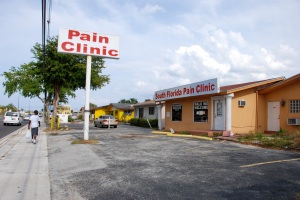The Sacklers of OxyContin infamy have become indelibly tied to the opioid crisis in America. But the truth is they were far from the only contributors to a drug epidemic that has claimed hundreds of thousands of lives in recent years.
Take Chris and Jeff George, for instance. The steroid-jacked twin brothers opened their first pain medication storefront in Florida in 2007 and before long, as they put it, “We were the Disneyland of pain clinics.” Their exploits are told in the CNN Films documentary American Pain, directed by Darren Foster, which premieres on CNN tonight.
“The George brothers did not start the opioid crisis,” retired FBI agent Kurt McKenzie notes in the film. “But they sure as hell poured gasoline on the fire.”
Director Darren Foster attends the ‘American Pain’ Premiere at SVA Theater on June 11, 2022 in New York City.
Photo by Jamie McCarthy/Getty Images for Tribeca Festival
Foster, an Emmy-winning filmmaker, first crossed paths with the Georges more than a decade ago.
“In 2009 I went down to Florida to report on the pill mills. One pain clinic had a reputation above all the others as being the biggest, the most liberal dispensers of oxycodone. And that was [the George Brothers’] American Pain,” Foster tells Deadline. “So, I knew I had to go there and film it. Little did I know that I would only be able to get one shot off of the clinic before I was surrounded by Chris George and a couple other very big employees… They chased me down I-95 for quite a bit of time.”
There was a veneer of legality around the George pain clinics – the brothers hired licensed medical doctors through Craigslist who were willing to write endless numbers of pain prescriptions after cursory examination of patients. In cases where patients couldn’t seem to legitimately claim an injury or condition that warranted pain medicine, they offered referrals to an MRI imaging service that operated from a semi parked in back of a strip club.

The George Brothers, Jeff (left) and Chris
CNN Films
As entrepreneurs the brothers came along at the right time. Eventually, they trafficked more than $500 million in pain pills.
“What happened is that Purdue Pharma [the Sacklers’ company] lost their patent on Oxycontin and it allowed all these generic companies to come in and make the same drug at a much cheaper price. That was the opportunity the George Brothers took advantage of,” Foster observes. “People who wanted to abuse these drugs were out there already because of OxyContin. They could actually get it at a much more affordable price because they were generics now. You didn’t need insurance, you could pay cash for them… [At the Georges’ clinics] there was no insurance taken, there were no credit cards taken, it was all cash only.”
Huge crowds came to the George’s dispensaries, not only locals but people from other states who made the trek in search of opioids. They could be in and out in a jiffy (often with a hefty supply of pills to resell at a higher price back home). Some patients lit into their stash right away, snorting drugs in the clinic parking lots.

One of the pain clinics owned and operated by the George Brothers in Broward County, Florida.
Photo by Stephanie Himango/NBCU Photo Bank/NBCUniversal via Getty Images via Getty Images
“That’s the craziest thing about the story, is that it was all happening in plain sight for everybody to see,” Foster says. “A lot about this was suspicious from the get-go. And the only question is how was it able to go on for so long? And I think the answer to that question on some level is that it was prescription drugs. It wasn’t cocaine or heroin where it was clear cut that it was an illegal drug. Everybody had plausible deniability for a long time. The doctors had their medical degrees and lab coats to hide behind. The patients had a prescription from the doctor that said that they were legally allowed to hold these medications, and the George Brothers had the doctors.”
There was another key participant in this scenario – the drug companies that manufactured the painkillers.
“There was a whole pharmaceutical industry standing by waiting, ready to supply [the Georges] and keep their shelves stocked,” Foster comments. “The story of American Pain illustrates how this drug crisis is uniquely made in America. We can’t point to a foreign cartel for supplying the drugs. These drugs were supplied by American pharmaceutical companies in massive quantities… It was really just a callous attitude. Instead of raising a red flag [about suspicious clinics], they say, how many more pills can we provide?”
American Pain will be available on demand beginning Monday to pay TV subscribers via CNN.com, CNN apps, and cable operator platforms. The film draws on wiretaps and undercover video to show how law enforcement ultimately busted the brothers, along with some of their hired medical staff. Chris George was released from prison after serving 11 years behind bars; his brother Jeff remains in prison. Foster questions whether, at a broader level there has been sufficient accountability for the opioid epidemic, given its enormous scale and death toll.
“I’ve met countless families who have lost people to this crisis. The magnitude of the devastation is unrivaled in the history of drugs in this country,” he says. “It is just so devastating. Whole cities, whole towns have been gutted because of this crisis. And I think the frustration for many of the victims’ families is that there’s just never been justice. Putting the George Brothers away for 10, 20 years – sure, it serves justice on some level — but at the end of the day, as big as they were, they’re still tiny compared to the pharmaceutical industry who made billions off of these drugs.”
Foster adds, “The George Brothers paid the price for what they did. But the pharmaceutical companies have yet to be criminally held liable for anything that happened in Florida during these times.”

